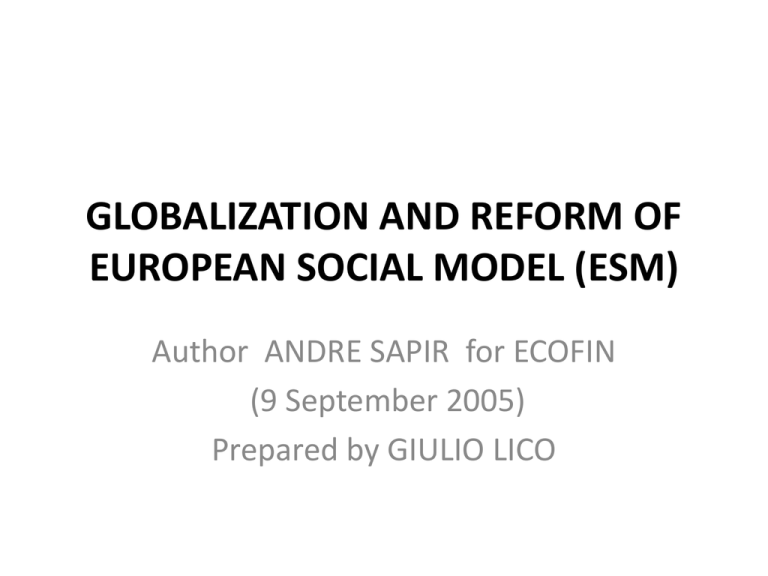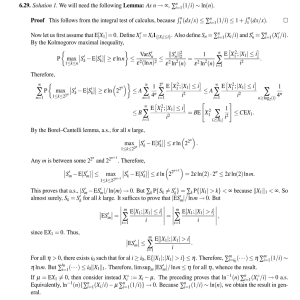GLOBALIZATION AND REFORM OF EUROPEAN SOCIAL MODEL (ESM) (9 September 2005)
advertisement

GLOBALIZATION AND REFORM OF EUROPEAN SOCIAL MODEL (ESM) Author ANDRE SAPIR for ECOFIN (9 September 2005) Prepared by GIULIO LICO GLOBALIZATION AND REFORM OF ESM Key issues/challenges of Europe in globalized world – EU: Key Performance Indicators (KPI ) priorities in “one world” – EU: enlargement deepening trade-off – Gauge of overall un-sustainability / unfitness of ESM ESM’s reform toward more flexibility is pivotal to EU’s future – Different LMSP recipes in MSs, suitable to each ESM’s taste – EU pushing through SMP, while MSs focusing on LMSP – Micro reforms (supply side) / macro ones coordination EU policies/history and perspective – SMP not fully implemented/rooted in yesterday’s thinking – Missed labour market reform hampers growth perspective – Missing ingredients Main policy equation to boost Europe EU Key Performance Indicators KPI priorities in “one world” Growth #1 in Europe to sustain peace and prosperity Today growth driven by innovation economy/flexible society Developing countries catch-up by trade/GDP/income distribution 1970 SHARE OF IMPORTS MANUF.GOODS IN DEVELOPED COUNTRIES FROM DEVELOPING ONES 10% SHARE % W. POPULATION 50% 11% 7% 5% 100% TODAY 45% 2% FROM CHINA DEVELOPING ASIA G7 EU-25 US WORLD 1985 % W GDP PPP 25% 45% 21% 21% 100% 15% EXPECTED P.A. GDP GROWTH NEXT YEARS 6% 2% 3% 4% Globalization is faster than EU institutional achievements Choice for EU is to make globalization an opportunity or a threat EU: Enlargement-Deepening trade off •SMP 27 for attractiveness of EU/ for comparative advantage •Rosy scenario by “elites”: enlargement as positive sum game if MSs labour market & social policies (LMSP) are conducive to change in specialization •as opposed to •Grey scenario NMS by “citizens”: enlargement as zero sum game where gains of new member states come at expense of old ones •Pan European industrial reorganization as threat / ↑ competition ↑ delocalization ↑ immigration •Enlargement by increasing social/economic completion/deepening of single market disparities is pit against the •Dysfunctional LMSP is a threat to currency union (€) •Public discontent/lack of consensus, yet surfaced in referendums and service directive, put single market project (SMP) in stalemate Gauge of overall un-sustainability/unfitness of ESM oNordic countries (Denmark, Finland, Sweden, Netherland) oHighest level of social protection expenditures oExtensive fiscal intervention on labour markets “active policy” oCompressed wage structure, low income disparities oAnglo-Saxon countries (UK, Ireland) oLarge social assistance of last resort oCash transfer primarily to working age people oConditional access to regular employment benefits oWeak unions, wide wage dispersion, high incidence of low-paid oContinental countries (Austria, Belgium, France, Germany, Luxembourg) oInsurance based unemployment benefits and old age pensions oStrong union and extensive coverage of collective bargaining oLow income disparities oMediterranean countries (Italy, Greece, Portugal, Spain) oSocial spending on old age pensions oSocial welfare on employment protection and early retirements oWage structure compressed, collective bargaining, strong unions oReduction of income inequality and poverty REDISTRIBUTION / VIA TAXES / TRANSFERS POVERTY AFTER TAXES / TRANSFERS NORDIC 42% 12% CONT 39% 12% ANGLO 39% 20% MED 35% 20% POVERTY < 60% AVERAGE DISPOSABLE INCOME Gauge of overall un-sustainability/unfitness of ESM • • Protection against uninsurable market risks provided by EPL and UB: Insiders (those with a stable and regular job) prefer EPL to UB • USA with lower unemployment => less social / more market insurance Gauge of overall un-sustainability/unfitness of ESM • Rewards to labour market participation • • • • Equity VS efficiency trade off The stricter the EPL of a model, the lower the employment rate The UB generosity plays a secondary role Poverty rate is weakly correlated with redistributive policy but mostly to distribution of human capital in the market, since the lower the level of secondary education, the higher the risk of poverty Gauge of overall un-sustainability/unfitness of ESM • • • • • Inefficient models are not sustainable in face of strains on public finances from globalization, tech. change, aging population DEBT/GDP RATIO MED 81% CONT 73% NORDIC 49% ANGLO 36% Non equitable model can be sustainable provided they reflect a viable political choice MED and CONT models must be reformed to efficiency by reducing disincentives to work and to growth with chosen path depending on political equilibrium (CONT to NORDIC, MED to ANGLO or....) Overriding reasons to reform inefficient welfare states – – Perceived un-sustainability Un-sustainability of CONT/MED to 2/3 of EU 25 and 90% of EU12 vs. Impairing EU. ESM reform towards more flexibility is pivotal to EU’s future • Given the structure of European governance, is there a case of coordination? – of labour market reforms (LMSP) among EU countries – of LMSP at national level with product/capital one at EU level – of structural reforms (supply side) with macroeconomic policy (with fiscal policy within responsibility of members states MS and monetary policy managed by ECB) Different LMSP recipes in MS, suitable to each ESM’s taste EES (European Employment Strategy) vs. OECD (Organization of Economic Cooperation Development) benchmarking. Conceiving/engineering LMSP reforms by MSs according to their own economic, social, political reality Coordination more an obstacle than a catalyst since it blurs, among public, responsibility about who is in charge of LMSP No votes in referendum as reactions of fear of unemployment, labour market reforms, globalization, privatization and consolidation of welfare states Disaffection is the primary political problem for European governments, since it’s directed both against poor economic performance and against reform measures designed to improve it Since surmounting EU deficit perception is difficult political problem for national governments, placing responsibility where power lies is crucial, so to MS’s EU pushing through full SMP, while MS focusing on LMSP Mutual interaction between product/capital market structure and labour market one In principle national labour market are domestic issue for MS with no spill-over, but since they interact with single market: the better they operate, the easier is to reform single market and vice versa. Chicken and egg dilemma is either to concentrate on EU product and capital market liberalization and expect that this will trigger labour market reforms at national levels through some “TINA” (There Is No Alternative) process or to act simultaneously at EU level and at national one with more synergy Lisbon agenda, as an attempt to enhance this two handed coordination, so far has poorly delivered Micro reforms (supply side) / macro ones coordination EU12 euro-zone share common currency, therefore common interest rate set by ECB with respect to average inflation in euro-zone To the extent, therefore, that structural reforms in one (or more) country affect the average inflation of euro-zone, there is scope for coordinating structural reforms Importance of coordination since reforms are costly in short term Therefore reforms are easier while accompanied by monetary expansion (to offset their effect on monetary demand) and by fiscal relaxation (to compensate the losers) ECB is unwilling to engage in formal coordination (it is independent) with the government of euro-zone Governments needs to act first to convince ECB they are serious about economics reforms; the more credible the reforms the greater the likelihood of a move by ECB Coordinated structural reforms would be a powerful signal for ECB and would help governments to bridge the confidence gap between EU governance and its citizens EU policies/history and perspectives SMP not fully implemented/rooted in yesterday’s thinking – Since 1993 only goods not yet services. – Focused on large internal market / economies of scale. – Less focused on today’s priority: new markets, labour retraining, R&D, education. Missed labour market reform hampers growth perspective – Without labour mobility at national level SMP is impaired. – The watered down Bolkenstein directive impairs 70% of EU GDP employment growth – Rigidity in services limits competitiveness of manufacturing sector and discourages foreign multinational investments – “polish plumber”; difficult reconciling between SMP in EU27 with economic social disparities with preservation of ESM for old MSs EU policies/history and perspectives • It is not the single market that threatens the “European Social Model”, but the inability to reform it in the face of rapid global changes, because “the freedom to provide services within the European Community” and world can’t be stopped: • Manufacturing in China and back offices in India • Manufacturing and services by NMS in proximity • Main policy equation to boost Europe – Full SMP + SGP reform + quality budget at EU level and LMSP reform at MS level, thereby: sustaining suitable ESM exploiting EU comparative advantage in the world – Europe at crossroad between two options Full integration with political will or Free trade area with less political will



